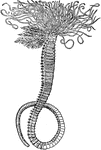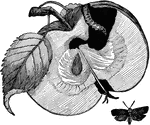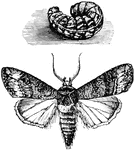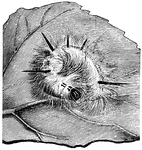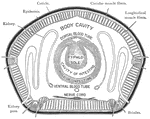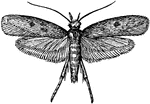
Sectional View of Acanthobdella
An illustration of a sectional view of a Acanthobdella, a member of the annelid family. "c, Coelom;…
Leodice antennata
"The Leodice antennata has the organs of locomotion attached to each segment; they are usually…
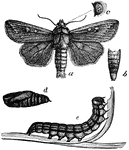
Army Worm
"Army-worm (Leucania unipuncta), about natural size. a, male moth; b, abdomen of female; c, eye; d,…

Bonellia Viridis (Female)
Illustration of a female green spoonworm. A, Proboscis cut short; B, bristle passing though the mouth…

Bonellia Viridis (Male)
Illustration of a male green spoonworm. A, Bonellia viridis; B, mouth; C, ventral hooks; and d, anus.…

Bonellia Viridis (Male)
Illustration of a male green spoonworm. A, Generative pore with spermatozoa; B, Anterior blind end of…
Double-Toothed Prominent Caterpillar
The caterpillar stage of the double-toothed prominent (Nerice bidentata) showing its serrated back.

Royal Horned Caterpillar
A large caterpillar with long, skinny horns. Usually a beautiful olive and crimson color.

Giant Centipede
"A Centipede is a worm having a long slender, depressed body, protected by coriaceous plates, 21 pairs…
Chaetognatha
Chaetognatha is a phylum of predatory marine worms that are a major component of plankton worldwide.…
Circulatory System of an Annelid
Anterior part of the circulatory system of an annelid. The arrows indicate the direction of the flow.…
Demoscolecida
"Demoscolecida, a group of minute marine worm-like creatures. The body tapers towards each end and is…
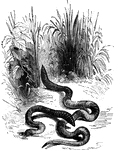
Earth-worms
"The bodies of these animals are of a cylindrical form, somewhat pointed at the anterior extremity,…

Earthworm
Dorsal view of internal structures of earthworm after cutting through the dorsal wall lengthwise and…
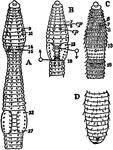
Earthworm
"Diagrams of various earthworms to illustrate external characters. A, B, C, anterior segments from the…
Earthworm
The earthworms are also known as megadriles, in the families Tubificidae, Lumbriculidae, and Enchytraeidae,…

Earthworm Anatomy
The earthworms are also known as megadriles, in the families Tubificidae, Lumbriculidae, and Enchytraeidae.…

Setae of Earthworm
An illustration of the various types of earthworm setae. Seta (plural: setae) is a biological term derived…

Dicyemennea Eledones Worm Found in Kidney of Octopus
A cross sectional view of the Dicyemennea Eledones, a parasite, found in Eledone Moschata, or musky…
Flatworm
Flatworms are flattened, leaf-like forms living in damp places on land, in freshwater streams of ponds,…
Flatworm
Flatworms are flattened, leaf-like forms living in damp places on land, in freshwater streams of ponds,…

Flatworm
Flatworms are flattened, leaf-like forms living in damp places on land, in freshwater streams of ponds,…
Flatworm
Flatworms are flattened, leaf-like forms living in damp places on land, in freshwater streams of ponds,…

Flatworm
Flatworms are flattened, leaf-like forms living in damp places on land, in freshwater streams of ponds,…

Flatworm
Flatworms are flattened, leaf-like forms living in damp places on land, in freshwater streams of ponds,…
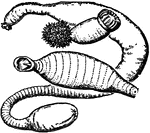
Gephyrea
Gepyrea is a name formerly given to a class of worms which included three families: (1) Priapulidae;…
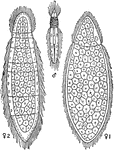
Rhopalura Gairdii Flat Worm
Illustration showing different rhompalura gairdii flat worms. The left and the right worms are the female,…
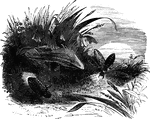
Glowworm
"The female is chiefly luminous. It is a flat, grayish-brown creature, rather more than half an inch…

Lob-worm
"Errantia means wandering, and is applied to numerous species, of which the Lob-worm or Lug-worm,…
Lugworm
"Arenicola marina. Entire animal viewed slightly from left side. Note anterior mouth; setae on anterior…

Mealworm
"Tenebrio Molitor. Commonly known as the mealworm or the mealworm beetle. Common in Europe and in this…
